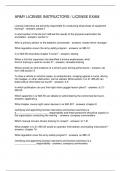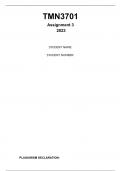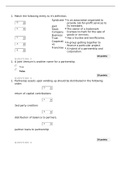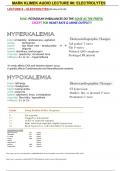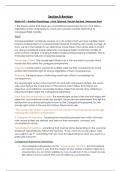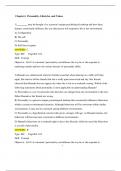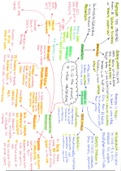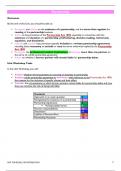TERROR MANAGEMENT THEORY:
Human beings have a biological desire for self-preservation but have an awareness
of the inevitability of death which can lead to a debilitating existential terror which is
managed by cultural worldviews + self-esteem.
(inspired by) Ernest Becker: humans are evolutionary predisposed towards survival
and are acutely aware of death. Our anxiety of death is concurrent with that it can
occur at any time for reasons we could not predict. The fact that we are aware of our
death is a reminder of that we are merely animals. The evolutionary resolution to stay
alive but having human awareness is psychological debilitating.
Humans manage problems with culture, such as death. Culture provides a sense that
life has meaning, It provides us standards of conduct and gives us a good self-esteem
that we are making valuable contribution which mitigates our anxiety.
Biological desire for self-preservation, awareness of inevitability of death =
existential terror, which leads to a cultivation of cultural worldviews and self-esteem.
Worldviews and self-esteem: Worldviews (+ self-esteem) do not, and cannot,
eradicate terror. It just manages it and keeps the terror at bay. Worldviews (+ self-
esteem) require continual validation and maintenance. Makes you feel more
confident.
TMT HYPOTHESES
MORTALITY SALIENCE HYPOTHESIS
If worldviews mitigate your fear of death, then when people are reminded of it, they
should cling on to their buffers more (AKA) If a psychological structure manages
death-related concerns, then reminders of death should heighten the need for that
structure.
Worldview defence: If worldviews buffer from death concerns, then mere presence
of alternative worldviews poses a psychological problem.
Reactions to others who:
▪ Support our worldview: increased liking, preference, more positive attitudes etc.
▪ Subscribe to alternative worldview: decreased liking, preference, less positive
attitudes, prejudice etc.
▪ (Rosenblatt et al., 1989) judges were recommended to give bail of $50 for
prostitutes & in CC they did, but when reminded of their death, they gave $450.
Shows that when people violate our worldview beliefs which buffer from death
concerns, get a punitive response.
MS & Worldview Defence (behavioural evidence): (McGregor et al. 1998)
liberal/conservative ppts were randomly assigned to read an essay that supported or
threatened their worldview, saying that it was written by another ppt. They then had to
allocate hot sauce to the other ppt who wrote the essay. When their worldview was
threatened, they were more likely to assign hot sauce to the ppt.
MS: Adherence to worldview norms: Responses to MS depend on what is
promoted within one’s worldview. If our worldview promotes tolerance, then we are
less likely to be prejudice.
Proximal defences (examples): sure, I will die but not right now. Idc, we all have to
die someday.
, Dual-process model: of managing death thoughts (Pyszcynski et al., 1999). Gives an
understanding of why a delay is needed. When exposed to a reminder of death, people
engage in proximal defences (conscious responses to rationalise or supress the
thoughts of death) but those thoughts come creeping back but that is when we engage
in distal defence which are non-conscious responses such as striving for our self-
esteem and our worldview.
EVIDENCE:
Cultural differences: TMT emphasises the importance of culture as a basis for self-
esteem. Eg. Japanese worldview VS America (Wakimato, 2006). In Japan they dislike
the personal success and do not speak proudly of their achievements and are likely to
stay humble compared to Americans.
Meta Analysis of MS effects: (Burke et al., 2010) of 277 MS exps. A statistically
significant moderate-large effect size (r= .35). Larger effects when using longer
delays (e.g., two or more delay tasks; 7-20 min).
Field experiments: Natural reminders of death should be able to provoke similar
reactions. Impact of interviewing people near graveyards, funeral homes provoked
similar reactions. 4
ANXIETY BUFFER HYPOTHESIS
If a psychological structure serves an anxiety-buffering function, then fortifying that
structure should satisfy terror management needs and reduce the need for further
buffering strategies.
If your sense of self is bolstered and worldview is showed to be correct, this should
buffer the fear of death. It acts as an anxiety buffer against death.
Immortality: according to TMT, the central goal is to transcend death.
Interpersonal relationships: serve a death anxiety buffering function (Florian et al.,
2002)
DEATH THOUGHT ACCESSIBILITY HYPOTHESIS
Death thought accessibility: If psychological structures manage death-related
concerns, then threatening these psychological structures should temporarily heighten
the accessibility of death-related thoughts.
▪ If our worldview is threatened, then that should temporarily to let death thoughts to
creep. ▪ Self-esteem threat increases DTA.
DTA in MS effects: (Wegner, 1994) ironic rebound effects, suppressing thoughts
lead to ironic rebound effects whereby the target thought becomes hyper-accessible
when suppression ends.
▪ Trying to supress the thoughts of death means that death thoughts become
rebounded later on (suppression-rebound thoughts).
SUMMARY:
■ TMT - awareness of death is a primary motivator of human behaviour
■ humans manage death concerns via worldviews and self-esteem, which provide a sense of literal or symbolic immortality
■ TMT can be applied to understand issues of prejudice, and intergroup conflict with evidence suggesting that MS increases
defensiveness towards culturally different others
THE ROLE OF DEATH IN LIFE II
, TMT HEALTH MODEL Three hypotheses:
H1: Health threats should increase DTA
H2: Health threats should lead to an immediate engagement of
proximal defences that…
▪ involve engaging in positive health behaviours (e.g., exercise,
use of sunscreen)
▪ avoiding and denying vulnerability to the threat (e.g.,
increased optimism regarding risks).
H3: Health threats after a delay should lead to the engagement
of distal defences that are based on self-worth concerns that
▪ promote positive health behaviours when self-worth is derived
from them (e.g., fitness)
▪ promote negative health behaviours when self-worth is
Health & death are intertwined. Health derived from them (e.g., smoking, binge drinking).
threats can arouse death thoughts due to
awareness of mortality.
Proximal defences have two responses: threat avoidance (no I won’t die, etc),
people engage in threat avoidance behaviours. Other response is to accept the threat a
and engage in tactics that might minimise the threat (health-orientated behaviour).
Regardless of the response, they both serve the same function: of pushing and
supressing the death thoughts.
After choosing the response, there is a heightened accessibility to non-conscious DTA
which will be accessible in the fringes of your conscience. Then there is the distal
defence.
TMHM EVIDENCE
(Arndt et al., 2006): proximal defences, looked at the intention of breast self-
examination. Health optimism measure (high vs low) was a moderator. They were
asked their intentions and in the MS condition.
(Hansen et al., 2010): distal defences, intention towards smoking. They used the
natural manipulation of advertising (smoking kills, highly addictive). After a delay
they saw if they smoked more/less and if smoking is linked to their self-esteem.
Found that people with low smoking self-esteem, had a low attitude to smoking and
the exact opposite for people with high smoking self-esteem.
TMHM IMPLICATIONS FOR HEALTH
It can be extrapolated that TMHM may provide insight into why people struggle to
adhere to health oriented behaviours (e.g., dieting, exercise regimes, intentions to
quit).
TMHM implies that fear appeals (e.g., risk of death) may be limited, and in some
cases, counter-intuitive.
TMHM proposes that self-worth, rather than health, concerns may lead to more
sustained engagement with health-oriented behaviours.
UNCOMFORTABLY NUMB

